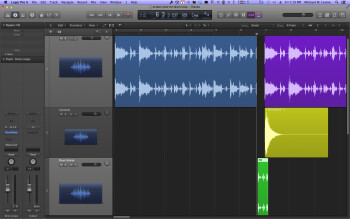Part 1 looked at the importance of variation in a full-length drum loop track, and also gave tips on customizing drum loops by editing. Here I’ll look at two very important aspects of your drum loop part, the fills and the crashes, and also touch on mixing issues.
Fill it up
Fills are a tricky when using drum loops. You definitely need them, as drummers almost always put a fill of some sort in the transitions between song sections and sometimes within the sections themselves (although much less often). But I’ve found that for a full-length song, some drum loop sets don’t give you enough fills to use a different one in each fill situation. If possible, you want to avoid repeating fills within a song, because that’s a giveaway that you’re using loops.
Compounding the problem, the fills from drum loop sets are sometimes over-the-top flashy and too long — often lasting from two beats to a full measure. Bombastic fills like that might not be appropriate for your song. That situation is another where you can use editing to your advantage. I’ve often cut up a fill and only used part of it. For instance, the last beat-and-a-half of it. Slicing up a fill doesn’t always work, but frequently it does. It also gives you the opportunity to create more than one fill from a single fill loop, thus increasing the number of fills at your disposal.
|
The highlighted fill was originally one bar in length, but was shortened to one and a half beats.
|
If you’re still short of fills, you can use editing to create simple ones. One I use a lot is a flammed snare hit, which is pretty easy to edit together (see the video from part 1, which shows how to do that, among other editing techniques). You do it by copying and pasting a snare hit into a secondary track that you create in your DAW for pasting in drum hits used in edits (discussed in part 1), and move it slightly later than the original snare to create the flam. If that doesn’t sound good by itself, adding a kick drum hit on the off beat that follows often rounds it out nicely.
Crashing the party
Crash cymbals present issues of their own. Many loop sets include versions of the main song sections with a crash on the downbeat. These are convenient in a way, but I prefer to have control over the level of the crashes, and inevitably there will be spots during the song, like accents inside of a measure, where you need additional crashes.
|
Instead of using loops with crashes in them, use a separate track for crash samples.
|
Because of those factors, I don’t use loops with the crashes included, but instead, create yet another stereo track that’s dedicated to crashes, and paste in individual crash samples (usually some come with the loop set). That way, I have complete control over the level of the crashes, and can put them wherever I want. In addition, if I planned to add compression on the main drum part and it had crashes in it, it would make them sound whooshy and strange. Having the crashes on a separate track avoids that problem.
Use one of the loops that has a crash as a reference for setting your crash track’s level. Finding a realistic crash level can be a little tricky — it’s easy to make it too loud.
All mixed up
Although stereo drum loops usually sound great, and the mixes are very professional, sometimes the mix isn’t right for your song. You don’t have a lot you can do in that case except to use EQ or multiband compression to try to boost or cut the frequencies of a particular drum. I’ve found that I can usually make the kick louder via boosting, without affecting the rest of the kit adversely. Changing the snare’s level is a lot more difficult. I would recommend resorting to EQing in this manner, only if the mix is really problematic.
Final thoughts
Using the pointers from parts 1 and 2 of this article, you should be able to assemble your drum loop parts more easily, and make them sound as realistic as possible. Don’t be afraid to use the editing tools in your DAW to make that happen.


